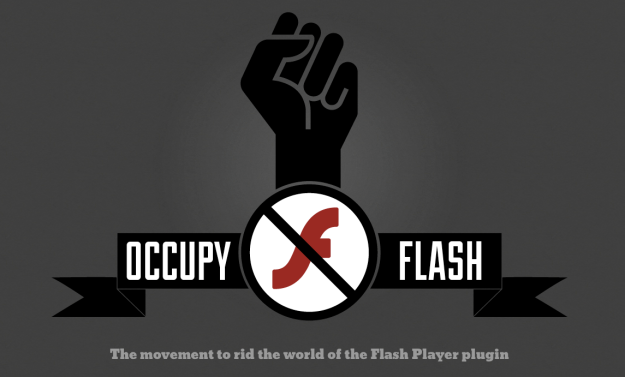
As ‘Occupy’ protesters around the country fight on the streets to eliminate the supremacy of the richest 1 percent of Americans, a new ‘Occupy’ movement has begun online. This time, however, the enemy is something else entirely: Adobe Flash.
As CNN reports, a group of developers calling themselves ‘Occupy Flash‘ are taking steps to end the use of Flash once and for all. In a “manifesto” posted to the Occupy Flash website, the group’s goal is to “get the world to uninstall the Flash Player plugin from their desktop browsers.” This, they believe, will usher in a new era where use of HTML 5 — the new universal Web standard used to display the same kind of vivid content Flash displays — becomes the norm.
What’s the motivation behind this, you ask? Occupy Flash explains:
Flash Player is dead. Its time has passed. It’s buggy. It crashes a lot. It requires constant security updates. It doesn’t work on most mobile devices. It’s a fossil, left over from the era of closed standards and unilateral corporate control of web technology. Websites that rely on Flash present a completely inconsistent (and often unusable) experience for fast-growing percentage of the users who don’t use a desktop browser. It introduces some scary security and privacy issues by way of Flash cookies. Flash makes the web less accessible. At this point, it’s holding back the web.
Despite these strong convictions against Flash, the group also notes that their campaign “is not a campaign against Adobe, or even their Flash platform,” since “there are plenty of good uses for it, such as building great Air applications.”
The Occupy Flash movement is not the only place where Flash is facing building resistance. In fact, Adobe itself recently announced that it will no longer develop Flash for the mobile Web. And, as 9to5Google points out, Google just suggested that developers use the Swiffy Extension, which allows users to publish vector animations to HTML 5 directly from Adobe Flash Professional.
Not everyone is happy, however; the Occupy Flash folks have reported received a barrage of angry emails. And some have even gone so far as to create a parody website, Occupy HTML, which blatantly mocks the Occupy Flash effort, and argues that, if you have Flash Player installed, then “you’re good; you get the best of both worlds.”
If you would like to join the Occupy Flash movement — which, according to the site, “has no corporate backing, and is not a lobbying effort of any sort” — simply uninstall Flash Player yourself. If you’re not sure how to do that, visit the Occupy Flash website, which will tell you automatically if Flash Player is installed on your machine, and follow the instructions for de-installation.
Please note: If you do uninstall Flash Player, a wide variety of Web content will not be viewable from your machine, at least until HTML 5 becomes even more prevalent. Hey, they don’t call it a “fight” for nothing.


